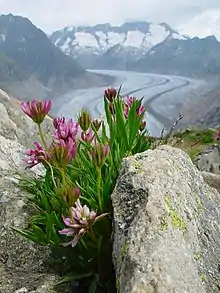Trifolium alpinum
Trifolium alpinum is a species of flowering plant in the legume family known by the common name alpine clover.[1] It is native to the Alps.[2]
| Trifolium alpinum | |
|---|---|
 | |
| Scientific classification | |
| Kingdom: | Plantae |
| Clade: | Tracheophytes |
| Clade: | Angiosperms |
| Clade: | Eudicots |
| Clade: | Rosids |
| Order: | Fabales |
| Family: | Fabaceae |
| Subfamily: | Faboideae |
| Genus: | Trifolium |
| Species: | T. alpinum |
| Binomial name | |
| Trifolium alpinum | |
This plant is a perennial herb with a large taproot which can be 1 metre long and 1 centimetre wide. The short stems bear ternate leaves divided into three leaflets each up to 5 cm long. The fragrant flowers are pink to light red, tinged with purple.[2]
This plant grows at elevations between 1700 and 2500 m,[2] sometimes up to 2800 m,[3] in subalpine and alpine climates. It commonly grows on acidic soils.[2]
In alpine regions this plant provides an important forage for livestock.[4] It is also good for stabilizing sites of erosion at high elevations.[5]
References
- USDA, NRCS (n.d.). "Trifolium alpinum". The PLANTS Database (plants.usda.gov). Greensboro, North Carolina: National Plant Data Team. Retrieved 15 December 2015.
- Site specific grasses and herbs: Trifolium alpinum. FAO.
- Codignola, A., et al. (1985). Preliminary studies on the photosynthetic structures of Trifolium alpinum L. as related to productivity. Ann Bot 55(4) 509-23.
- Lauga, B., et al. (2009). Two lineages of Trifolium alpinum (Fabaceae) in the Pyrenees: evidence from random amplified polymorphic DNA (RAPD) markers. Acta Botanica Gallica 156(3) 317-30.
- Peratoner, G., et al. (2007). Growth of Trifolium alpinum: Effects of soil properties, symbionts and pathogens. Ecological Engineering 30(4) 349–355.
This article is issued from Wikipedia. The text is licensed under Creative Commons - Attribution - Sharealike. Additional terms may apply for the media files.